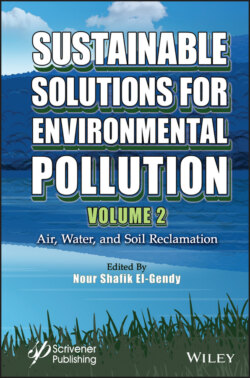Читать книгу Sustainable Solutions for Environmental Pollution, Volume 2 - Группа авторов - Страница 10
Оглавление
Preface
Environmental pollution comes from the introduction of pollutants whatever: foreign substances/energies or naturally occurring contaminants into nature which consequently negatively impact it and cause many adverse effects. There are many forms of pollution: air, soil, water, noise, visual, thermal, radioactive, litter, plastic, light and others. All such forms of pollution withdraw the accomplishment of the seventeen goals of sustainable development, negatively affect human health, ecosystem, and biodiversity and abolish life on earth. The worldwide increased inhabitants with the elevated industrial and agricultural activities come in parallel with the depletion of water and high quality energy resources. This book volume emphasizes on the three important forms of pollution; air, water and soil.
Air pollution occurs via natural and human-made (anthropogenic) sources, for example; sudden massive forests fires and open burning of agricultural wastes and municipal solid wastes in landfills, in addition also to the open burning of oil spills, all increase the greenhouse gas (GHG) emissions. Besides, the decrease of high quality low sulfur content oil reserves forced oil industry to go to heavy crude oil with high sulfur, nitrogen, aromatics and asphaltene content. That led to an extra load during oil extraction and refining in addition to the production of transportation fuels with high sulfur and nitrogen contents which upon their combustion also increase the GHG emissions, particulate matters, aromatics, and sulfur and nitrogen oxides. All of these add to the problem of climate change, and cause what is called acid rains which adversely affect human health, ecosystem, life underneath water and on land, and cause soil erosion and deforestation. The increased strict environmental regulations for lowering sulfur content in the transportation fuels add to the overall expenses of oil refineries. That forced oil industries to search for alternative and/ or complementary sustainable, ecofriendly and cost-effective techniques for upgrading the quality of the oil fractions, products and transportation fuels.
With the global water scarce problem, available water resources are exposed to many industrial and agricultural effluents, sudden occurrence of oil spills, contaminants from shipping and trading activities, and the uncontrolled massive discharge of plastic and food wastes. Consequently, it becomes contaminated by organic and inorganic pollutants, heavy metals, plastic debris and other solid wastes. Those negatively affect the life underneath water, fish population, coral reefs, aquatic biodiversity, coastal areas and touristic activities, besides, algae which produce approximately 50% of the atmospheric oxygen with the simultaneous photo-autotrophic consumption of GHG-CO2 and also lead to extinction of some aquatic inhabitants.
Soil pollution can occur from oil industrial activities, uncontrolled use of pesticides and fertilizers, leachates of heavy metals and other xenobiotics from municipal wastes landfills. It is a real threat as such pollutants would present in agricultural systems, crops and plants, reach directly to human through food chain and indirectly through the intake of meat and milk products from animal and cattle accumulated such pollutants in their organs via the up-taking of polluted plants and crops.
The use of nature-based solutions (NBSs) as sustainable and greener option for management and remediation of polluted sites and upgrading of oil products are not only an environmental preference, but they are also a strategic worldwide choice in the modern economy. Thus, bio-based practices, for example; phyto- and bio- remediation, biosorption, biodesulfurization, etc., are denoted as promising, ecofriendly, economic and impactful techniques than the conventional physical and chemical processes.
This book interprets and links various sources of environmental pollution with different human activities and industrialization. It covers the basic concept of bio- and phyto- remediation and most up-to-date solutions for remediation of polluted environment; air, water, and soil from organic and inorganic pollutants and pathogens. It expounded the development of phycoremediation, electro-bioremediation based on a passive redox control of microorganisms, constructed wetlands, the promising biosurfactants, the biosynthesis of metal oxide nanoparticles and their applications for environmental reclamation, novel membranes catalytic reactors and sand filtration in addition to recyclable porous adsorbents for capturing GHG and other applicable biosorbents for water treatment from polluting heavy metals and other organic pollutants. It goes through the bio-upgrading of crude oil and its fractions to indirectly overcome air pollution and mitigate the problem of climate change. It elucidated some case studies for environmental reclamation and discusses also challenges and opportunities of the implementation of such natural based solutions to reach a clean and sustainable environment.
The chapters are: Chapter 1 - Natural-Based Solutions for Bio-Remediation in Water Environment; Chapter 2 - Removal of Heavy Metals from the Environment by Phytoremediation and Microbial Remediation; Chapter 3 - Bioremediation as a Sustainable Solution for Environmental Contamination by Petroleum Hydrocarbons; Chapter 4 - Pollution Protection Using Novel Membranes Catalytic Reactors; Chapter 5 - Removal of Microbial Contaminants from Polluted Water Using Combined Biosand Filters Techniques; Chapter 6 - Biosurfactants: Promising Biomolecules for Environmental Clean-up; Chapter 7 - Metal Hyper-accumulation in Plants: Biological Mechanisms and Phyto-technologies; Chapter 8 - Microbial Remediation Approaches For PAH Degradation; Chapter 9 - Biomorphic Synthesis of Nanosized Zinc Oxide for Water Purification; Chapter 10 - Pollution Dynamics of Urban Catchments; Chapter 11 - Bioupgrading of Crude Oil and Crude Oil Fractions; Chapter 12 - Recyclable Porous Adsorbents as Environmentally Approach for Greenhouse Gas Capture.
The discussed multidisciplinary sustainable approaches in this book for environmental reclamation highlighted the importance of scientific and engineering disciplines to reach all other disciplines including economics, politics and other social sciences. Accordingly, it is time for interdisciplinary efforts from chemists, biologists, microbiologists, ecologists, mathematicians, statisticians, engineers, medical doctors, economists, politicians, and military officers, governmental and non-governmental organizations to put hand to hand together for recruitment of all available resources for the reclamation of environment from air, water and soil pollutants to achieve the three pillars of sustainability: economic, environmental, and social.
Nour Sh. El-Gendy
